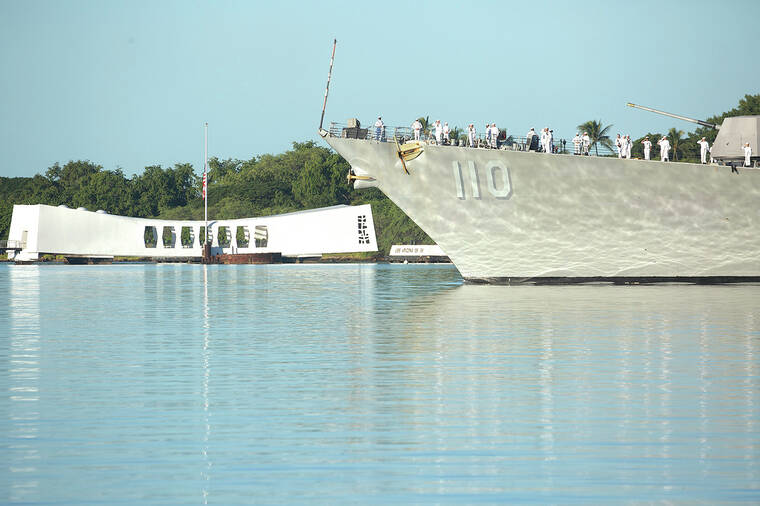Navy in court over Pearl Harbor water contamination
WASHINGTON — Not since the dark day at Pearl Harbor that drew America into World War II has there been so much trouble in paradise, as the U.S. naval base on the Hawaiian island of Oahu is sometimes described.
A gusher of jet fuel that leaked into the base’s drinking water in November 2021 led to a lawsuit that forced the Navy to admit it was negligent in maintaining the gigantic fuel tanks built into a mountain at the start of the war, in a depot known as the Red Hill Bulk Fuel Storage Facility.
Now the case, with more than 2,500 plaintiffs so far and about 5,000 more expected to join, is before a federal judge in a trial that started this week in Honolulu to determine the extent of the damages to those exposed to the contaminated water.
The plaintiffs — mostly civilians along with a few hundred military personnel — say the effects were calamitous, with illnesses ranging from nausea and skin rashes to cysts and polyps, as well as serious health problems in their children. Some of the affected families say the impacts have been devastating for their finances and careers, and most say they no longer trust the Navy that has been an iconic presence at Pearl Harbor for more than a century.
“This is a case about a government that poisoned its people,” said Kristina Baehr, attorney for the victims and founder of Just Well Law based in Austin, Texas. “And I don’t use that word lightly. They knew the water was contaminated and let thousands of people get sick.”
After the Nov. 20, 2021, accident that caused about 19,000 gallons of jet fuel to spill into the water supply that serves about 93,000 people at Pearl Harbor, the Navy did not alert residents until many started reporting symptoms such as nausea, vomiting, diarrhea, migraines and lethargy during the long Thanksgiving weekend of Nov. 25-28, according to the lawsuit. Even then, the Navy waited until Dec. 2 — 12 days after the spill — to announce that petroleum products had been found in the water supplies, it said.
Comparisons are being drawn to the debacle at Camp Lejeune, the Marine Corps base in North Carolina where the drinking water was contaminated for decades without any warnings to those exposed. The Defense Department is still fighting damage claims by thousands of former Marines and family members. Thanks to an act of Congress in 2022 opening the door to lawsuits by Camp Lejeune victims, those cases are on track for hearings before federal judges in North Carolina this summer.
“At Camp Lejeune, the government didn’t admit the harm until it had to,” Baehr said. “At Red Hill, they literally waited until thousands of people could smell it and were getting sick and going to emergency rooms.”
A history of pollution
The 2021 spill was not the first for Red Hill, a fuel depot containing 20 giant tanks, each large enough to hold a 20-story building, built under 100 feet of volcanic rock to withstand enemy attacks. A November report by a group of state and local officials organized as the Red Hill Water Alliance Initiative estimated there have been at least 70 leaks since the facility was completed in 1943, spilling as much as 2 million gallons of fuel into the environment.
“For this to occur over a period of 80 years just 100 feet above an aquifer on an island that cannot replace its water source presents an existential challenge,” the report said.
The spill in 2021 was actually the result of two accidents: A mistaken valve opening on May 6 that released the jet fuel into the Red Hill system, then a train cart breaking a pipe on Nov. 20 that allowed the fuel to flow into the water supplies.
Navy officials initially apologized for the delay in notifying residents about the spill, and in a joint stipulation filed in federal court in May 2023, the Navy admitted its negligence in operating Red Hill and acknowledged that some plaintiffs “suffered injuries compensable under the Federal Tort Claims Act (FTCA).”
That stipulation marked the first time a group of plaintiffs was successful in a mass tort claim against the U.S. government for environmental damages under the FTCA, Baehr said. “There have been other cases against the United States for environmental torts,” including claims for damages at Camp Lejeune, she said. “But this is the first one that we know of that succeeded.”
Now it will be up to U.S. District Judge Leslie Kobayashi to decide on damages in a half-dozen “bellwether” cases, “and we will take those numbers and try to reach a deal with the government” on compensation for other plaintiffs, Baehr said. She said she expects the trial to take two to three weeks, with a decision by the judge on damage amounts later this year.


